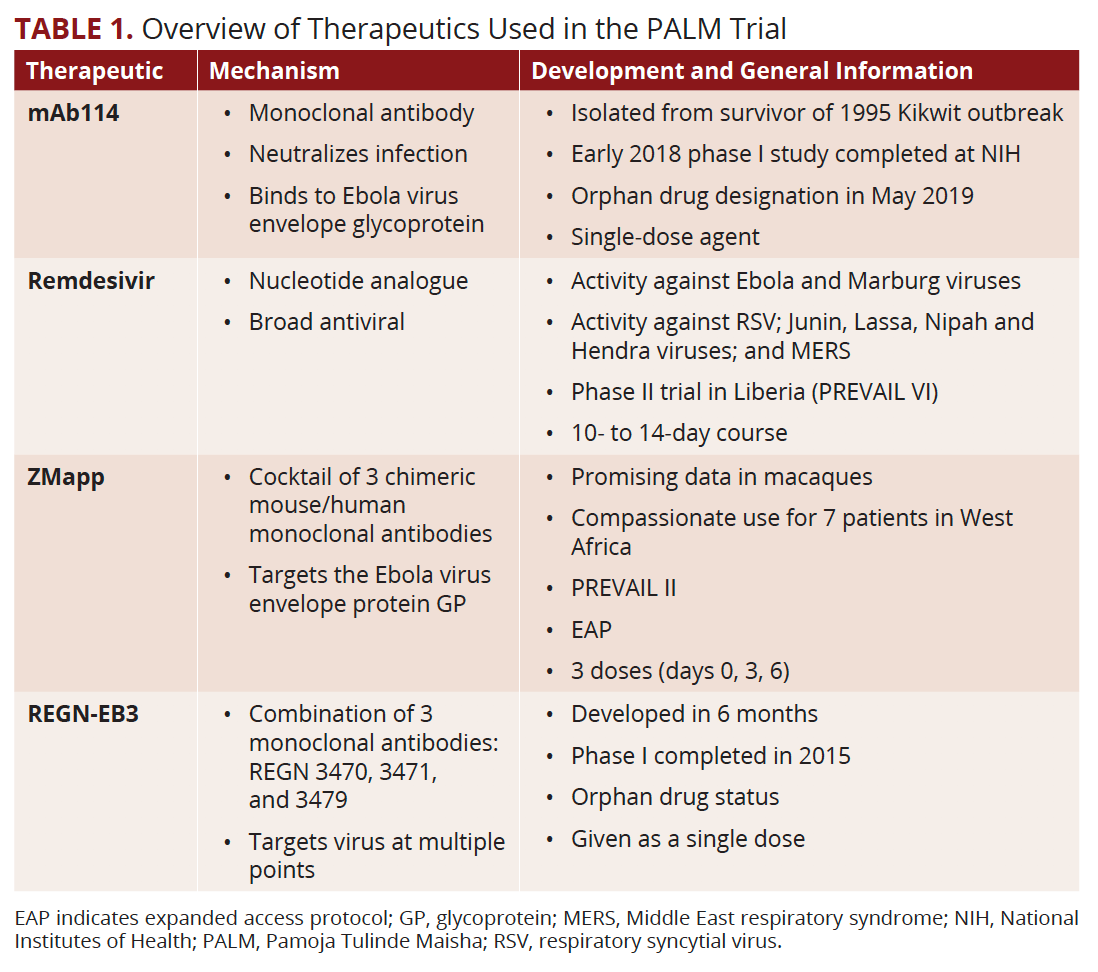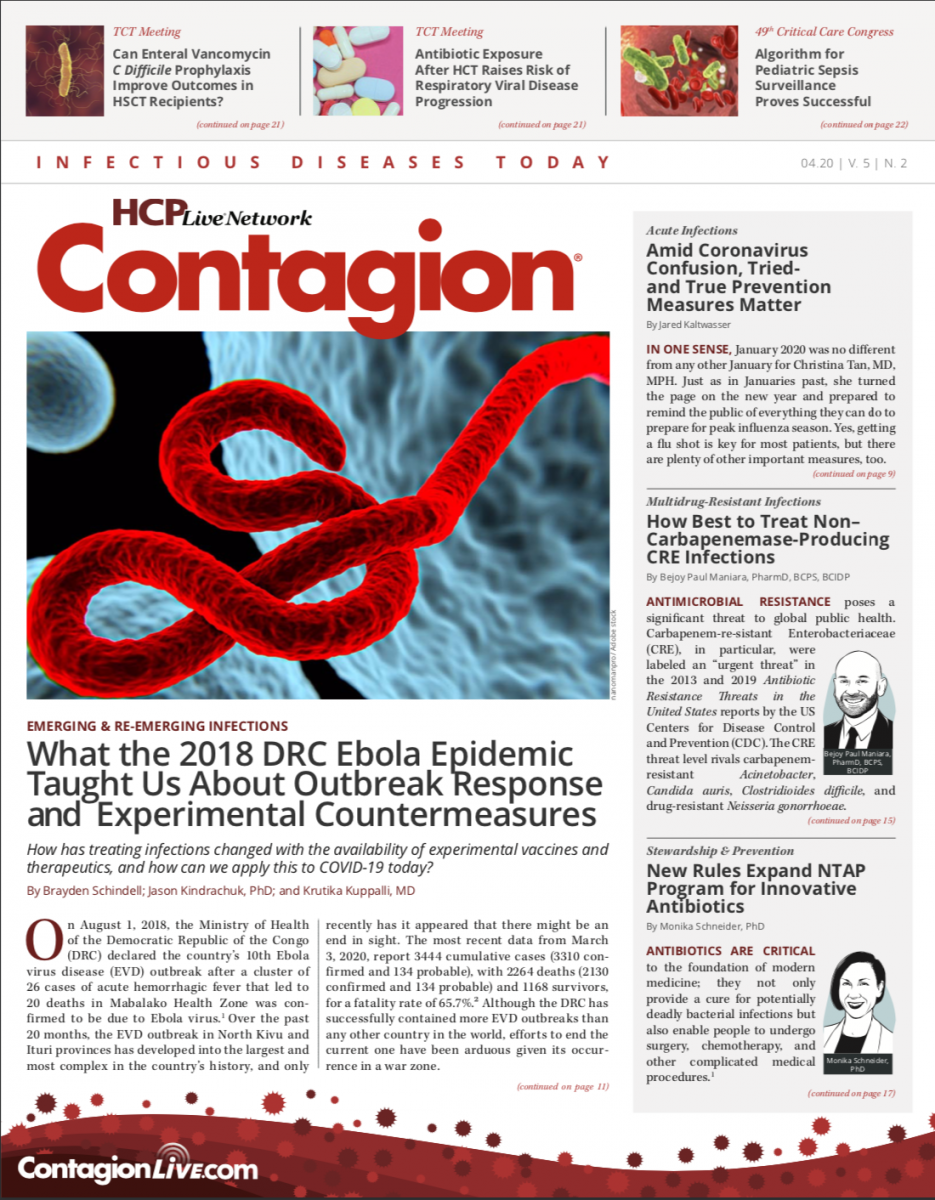What the 2018 DRC Ebola Epidemic Taught Us About Outbreak Response and Experimental Countermeasures
How has treating infections changed with the availability of experimental vaccines and therapeutics, and how can we apply this to COVID-19 today?
On August 1, 2018, the Ministry of Health of the Democratic Republic of the Congo (DRC) declared the country’s 10th Ebola virus disease (EVD) outbreak after a cluster of 26 cases of acute hemorrhagic fever that led to 20 deaths in Mabalako Health Zone was confirmed to be due to Ebola virus.1 Over the past 20 months, the EVD outbreak in North Kivu and Ituri provinces has developed into the largest and most complex in the country’s history, and only recently has it appeared that there might be an end in sight. The most recent data from March 3, 2020, report 3444 cumulative cases (3310 confirmed and 134 probable), with 2264 deaths (2130 confirmed and 134 probable) and 1168 survivors, for a fatality rate of 65.7%.2 Although the DRC has successfully contained more EVD outbreaks than any other country in the world, efforts to end the current one have been arduous given its occurrence in a war zone.
BACKGROUND OF THE EPIDEMIC
With approximately 80 million individuals, the DRC is the fourth most populous country in Africa.3 Decades of fighting between government forces and armed militia groups vying for control in the eastern part of the country has led to one of the longest and most complex global humanitarian crises. Over 4 million Congolese have been displaced within the country, and over 800,000 have fled to surrounding countries.4,5 Exploitation of the region’s vast mineral and other resources has fueled conflict, leading to illegal trade and human rights violations, including massacres, kidnappings, violence against women and children, human trafficking, and forced recruitment of children into militant groups.6 Years of atrocities led to a frail economy, weak political system, and poor health care infrastructure, creating a dearth of basic public health services such as water sanitation hygiene programs, vaccinations, and communicable disease prevention and surveillance. The breakdown of basic services combined with ongoing violence has made it difficult to detect and control communicable diseases, allowing for ongoing cholera, measles, and polio outbreaks and creating a perfect storm for the emergence of an Ebola outbreak.7
The DRC’s longstanding socioeconomic challenges combined with mistrust in the government because of prolonged violence also damaged community support of humanitarian agencies such as the World Health Organization (WHO) and Doctors Without Borders, or Médecins Sans Frontières (MSF).8,9 The deep-seated community mistrust led to rumors that Ebola is a myth and fear among patients and family members about accessing care, leading to forced removal of patients and attacks on Ebola treatment centers (ETCs).10,11
A turning point of this epidemic was the death of WHO epidemiologist Richard Valery Mouzoko Kiboung, PhD, on April 19, 2019, during an attack on Butembo University Hospital after a series of health care worker attacks.12 Armed militia groups’ sustained attacks on frontline responders and ETCs resulted in the withdrawal of operations in eastern DRC by the US Centers for Disease Control and Prevention (CDC) and closure of ETCs by MSF.
Despite the challenges of the current Ebola outbreak, one of the greatest stories has been the development of medical countermeasures (MCMs). During the course of this epidemic, the Merck vaccine Ervebo obtained US Food and Drug Administration (FDA) approval, and a randomized clinical trial of therapeutics was stopped early because it showed efficacy for mAb114 and REGN-EB3n. The investment and development of these MCMs demonstrate what can be achieved when the scientific community unites against 1 cause.
IMPACT OF VACCINATIONS
Quick implementation of Merck’s recombinant vesicular stomatitis virus—Zaire ebolavirus (rVSV-ZEBOV) vaccine at the start of the North Kivu–Ituri EVD outbreak was instrumental in preventing a larger emergency on the African continent. The single-dose vaccine protects against Zaire ebolavirus and is a modified vesicular stomatitis virus vector loaded with the Ebola glycoprotein.13 The vaccine was initially deployed during the 2018 Équateur Province EVD outbreak in northwest DRC that ended 7 days prior to declaration of the North Kivu—Ituri outbreak. Because appropriate regulatory approvals had been obtained, ring vaccination campaigns were initiated almost immediately after the outbreak was declared.
In April 2019, WHO released an interim data analysis of the vaccine’s effectiveness, announcing that it demonstrated a 97.5% protection rate. More than 90,000 individuals had been vaccinated at the time, with 71 going on to develop EVD. Of those patients, 56 developed EVD fewer than 10 days after vaccination, indicating they had not gained full immunity from the vaccine.14 None of the individuals who developed EVD 10 days or more after vaccination died of the disease.14 Based on these results, the vaccine received conditional marketing authorization by the European Commission on November 11, 2019, and the US Food and Drug Administration (FDA) approval on December 20, 2019, under the name Ervebo.13 The DRC, Ghana, Zambia, and Burundi have agreed to license the vaccine, which will allow Merck to stockpile and distribute it in countries at risk of EVD outbreaks. More recently, the CDC’s Advisory Committee on Immunization Practices voted unanimously that healthy US adults 18 years or older at occupational risk of Ebola be vaccinated with Ervebo.15 To date, over 290,000 individuals in the DRC have received this vaccination.2
The other candidate vaccine under evaluation is Ad26.ZEBOV/MVA-BN-Filo, developed by Janssen pharmaceutical and administered as 2 doses given 56 days apart.2,16 This vaccine is modified to induce production of Ebola virus proteins and trigger an immune response.16 There were numerous debates over its introduction into the outbreak response because of concerns that adding a second vaccine requiring 2 doses rather than 1 could lead to confusion and worsen community mistrust. Ultimately, the WHO, in conjunction with Institut National de la Recherche Biomédicale in Kinshasa decided to administer the Janssen vaccine to at-risk populations in areas without active disease transmission; it was introduced in Goma, the capital of North Kivu, in November 2019, with over 16,000 individuals vaccinated.2
SUCCESS OF THERAPEUTICS
The development and evaluation of therapeutics against EVD has been the outbreak’s other great success story. The Pamoja Tulinde Maisha study was a large consortium therapeutics trial with the primary objective of looking at the 28-day mortality of investigational therapeutics (mAb114, remdesivir, REGN-EB3) compared with ZMapp as the control arm (Table).17,18 The study was designed to enroll patients equally stratified among all 4 arms who were confirmed to be Ebola polymerase chain reaction positive and began enrollment in November 2018. The study was monitored by an independent data safety and monitoring board, and on August 8, 2019, after reviewing the data, the board recommended stopping enrollment and continuing an extension phase with mAb114 and RGN-EB3.17
The final analysis of 673 eligible patients demonstrated that 76.5% were at least 18 years old, 56% were female (17 pregnant) at the time of EVD diagnosis, and average duration of symptoms prior to enrollment was 5.5 days.17 The 28-day mortality was 50% (84 of 169) for ZMapp, 53% (93 of 175) for remdesivir, 35% (61 of 174) for mAb114, and 34% (52 of 155) for RGN-EB3. Patients who received mAb114 or RGN-EB3 cleared serum viremia faster than those who received ZMapp. Overall, 96% of deaths occurred within 10 days of enrollment. Longer duration of symptoms, higher serum viral level, impaired renal function, and elevated aspartate aminotransferase/alanine aminotransferase were associated with greater risk of death.17 The extension phase of the study is ongoing in the DRC.
A TESTAMENT TO UNITY
Although the DRC EVD outbreak has been plagued by community mistrust and violence that have prolonged this epidemic, without the use of vaccines and therapeutics, this disease threatened the entire security of the African continent. As of this writing, there have been no new EVD cases in the DRC for 14 days, and all patients have completed treatment. Because we are, hopefully, in the waning days of this epidemic, it should be noted that this outcome would not be possible without the extraordinary international effort, particularly of the frontline workers who risked their lives to ensure that patients received appropriate medical attention. This is a testament to what can happen when we unite during a public health emergency. Now, can we apply what we've learned to respond to the coronavirus disease 2019 (COVID-19) pandemic?

Schindell is a doctoral student working with Jason Kindrachuk, PhD, in the laboratory for Molecular Pathogenesis of Emerging Viruses, Department of Medical Microbiology and Infectious Diseases, at University of Manitoba in Winnipeg in Canada. His research focuses on transmission of Ebola virus and the long-term health outcomes of survivors of the disease it causes.Kuppalli is vice chair of the IDSA Global Health Committee. She is an assistant clinical professor at Stanford University School of Medicine and faculty fellow in the Center for Innovation in Global Health, as well as a 2020 Emerging Leader in Biosecurity Fellowship through the Johns Hopkins Center for Health Security. She was the medical director for an Ebola treatment unit in Sierra Leone during the West African outbreak, helped lead the development and implementation of pandemic response preparedness activities in resource-limited settings, and consulted on the development of therapeutics for emerging pathogens. She also has worked in Ethiopia, India, Uganda, and Haiti. Kindrachuk is an assistant professor and Canada Research Chair in the molecular pathogenesis of emerging and re-emerging viruses in the Department of Medical Microbiology at University of Manitoba. His research program focuses on the investigation of emerging virus circulation, transmission, and pathogenesis, primarily those that pose the greatest threat to global human and animal health.
References:
1. World Health Organization Africa Regional Office. EBOLA VIRUS DISEASE | Situation Report 30 | Democratic Republic of the Congo. 2018:8-10. https://apps.who.int/iris/bitstream/handle/10665/273640/SITREP_EVD_DRC_20180807-eng.pdf?ua=1%0Ahttps://apps.who.int/iris/bitstream/handle/10665/310996/SITREP_EVD_DRC_20190226-eng.pdf?ua=1%0Ahttps://apps.who.int/iris/bitstream/handle/10665/311242/SITREP_EV.
2. Technical Secretariat of the National Multisectoral Committee for the Response to Ebola Virus Disease (CMRE). http://translate.google.com/translate?hl=auto&langpair=auto%7Cen&u=https%3A%2F%2Fus3.campaign-archive.com%2F%3Fu%3Db34a30571d429859fb249533d%26id%3D76c94d6e4d. Published 2020. Accessed March 3, 2020.
3. World Bank-Democratic Republic of Congo Data. https://data.worldbank.org/country/congo-dem-rep. Accessed May 26, 2019.
4. The Lancet. DR Congo: managing Ebola virus in war. Lancet. 2018;392(10155):1280. doi:10.1016/s0140-6736(18)32395-x
5. UNHCR. https://www.unhcr.org/dr-congo-emergency.html. Accessed May 26, 2019.
6. ICRtoP. International Coalition for the Responsibility to Protect. http://www.responsibilitytoprotect.org/index.php/crises/crisis-in-drc. Published 2009. Accessed May 26, 2019.
7. WHO 2018. Overview - Contents. Bull World Health Organ. 2018;(week 42):1-20.
8. Cousins S. Violence and community mistrust hamper Ebola response. Lancet Infect Dis. 2018;18(12):1314-1315. doi:10.1016/s1473-3099(18)30658-3
9. Gostin LO, Kavanagh MM, Cameron E. Ebola and War in the Democratic Republic of Congo: Avoiding Failure and Thinking Ahead. JAMA - J Am Med Assoc. 2019;321(3):243-244. doi:10.1001/jama.2018.19743
10. Nakkazi E. DR Congo Ebola virus outbreak: responding in a conflict zone. Lancet (London, England). 2018;392(10148):623. doi:10.1016/S0140-6736(18)31981-0
11. Vinck P, Pham PN, Bindu KK, Bedford J, Nilles EJ. Institutional trust and misinformation in the response to the 2018—19 Ebola outbreak in North Kivu, DR Congo: a population-based survey. Lancet Infect Dis. 2019. doi:10.1016/S1473-3099(19)30063-5
12. Kuppalli K. Health workers are being killed while trying to fight Ebola in the Congo. The Hill. 2019.
13. FDA. First FDA-approved vaccine for the prevention of Ebola virus disease, marking a critical milestone in public health preparedness and response.
14. WHO. Preliminary results on the efficacy of rVSV-ZEBOV-GP Ebola vaccine using the ring vaccination strategy in the control of an Ebola outbreak in the Democratic Republic of the Congo: an example of integration of research into epidemic response.
15. Brown T. CDC Panel Recommends Ebola Vaccine for Adults With Exposure Risk. Medscape. https://www.medscape.com/viewarticle/925810. Published 2020. Accessed February 29, 2020.
16. Anywaine Z, Whitworth H, Kaleebu P, et al. Safety and Immunogenicity of a 2-Dose Heterologous Vaccination Regimen with Ad26.ZEBOV and MVA-BN-Filo Ebola Vaccines: 12-Month Data from a Phase 1 Randomized Clinical Trial in Uganda and Tanzania. J Infect Dis. 2019;220(1):46-56. doi:10.1093/infdis/jiz070
17. Mulangu S, Dodd LE, Davey RT, et al. A randomized, controlled trial of Ebola virus disease therapeutics. N Engl J Med. 2019;381(24):2293-2303. doi:10.1056/NEJMoa1910993
18. Mulangu S. 843. The PALM Consortium: A Multicenter, Multioutbreak Randomized Controlled Trial of Ebola Virus Disease Therapeutics. Open Forum Infect Dis. 2019;6(Supplement_2):S12-S13. doi:10.1093/ofid/ofz359.028

